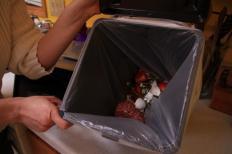







“One year ago he couldn’t open the case well, but now he can,” said his mother, Amber Lucsay, proud to see his progress. “Now he knows things don’t all go into one bin.”
The city’s organic collection pilot program provided the black case to the Lucsay family, and every day after dinner, they throw away their unwanted leftover vegetables, meat, fish, and so on into this bin, dump it into another big black cart, and leave it to the city for a special, weekly curbside collection.
Lucsay’s family, among the 550 or so households participating in Madison, joined the city’s organic collection pilot program right after it started in June 2011. This program collects the city’s organic trash, including food waste, yard waste, sullied paper, and even pet waste -- all of which accounts for 35 to 40 percent of Dane County’s landfill.
Entering its third year, the pilot program is about to expand its volume of participants and develop an anaerobic digester in Madison to process this waste. They currently ship the waste to the Columbia County Composting Facility.
“For years we’ve been looking at ways to treat the organics,” says George Dreckmann, the city’s recycling coordinator, who has been doing this for 10 years, “It became obvious that this is the best way.”
A proposal in 2012 for the city’s 2013 budget once worried Dreckmann as it threatened to remove the $150,000 of funding for the program.
“I don’t think [the common council] fully understood the implications of cutting the money. We were at the point that we could not keep it going and might stop the project,” said Dreckmann.
To his relief, now the $150,000 has been put back into the budget and will be used to hire an engineering consultant to design the project and do more testing on the organic material.
“We think the program has a high likelihood of success,” says Mayor Paul Soglin, “the preliminary work tells us that the value of the energy we create as well as the composting will exceed the cost of the program.”
With the financial support to continue the program, the next step will involve grocery stores, restaurants, hospitals, universities, and other institutions with food services into the program. The Madison Children's Museum and the Fair Oaks Diner have been participating in the pilot program.
In 2014, the pilot program looks to bring in up to 1,000 households in different areas of the city. Right now the program extends to the near east side, the far southwest corner of Madison, and parts of Fitchburg. Dreckmann hopes the program will serve the whole city in the next two or three years.
The ultimate goal is to build up an anaerobic digester in 2015 or 2016 that can turn the organics into electricity and renewable energy. The digester mainly produces methane gas, which could be used as fuel, and a solid or liquid compost, which would be sold to farmers as a fertilizer.
“[In 2013] we are going to develop a plan for the digester, and next, start the construction, go out to talk to companies for material contracts,” said Dreckmann, “and go to other communities like in Fitchburg, Middleton, to see if they are willing to bring the material here as well.”
The pilot program kept 198 tons of trash out of the landfill in 2011, a small number compared to the annual dump of 48,000 tons in Madison. But the potential for the full-scale program – once it’s carried out – is huge: at least 20,000 tons annually. Dreckmann expects the capacity to be 30,000 tons for the digester, to possibly reach 60,000.
“The Dane County landfill’s expansion plan will last 20 to 30 years more,” said Dreckmann. “If we put out the 20,000 tons, that’s a big saving.”
The exact cost of the digester remains uncertain. Depending on the type and size of system that will be built, the cost of disposal will range between $35 and $85 per ton. Landfill disposal currently costs $42 per ton, and Dreckmann expects it to increase $8 to $10 in the future. He hopes the maximum fee of the new program won’t exceed more than $50, to remain competitive with the landfill.
Over the first one-and-a-half years of the pilot program, participants have provided feedback.
“We’ve been testing people’s attitude about it,” Dreckmann said. “Most people like the idea.”
Josh Peterson, another participant of the pilot program, used to live near East High School in one of the pilot neighborhoods. Since his family moved to a new area shortly afterwards, he started promoting it among his new neighbors.
“We are the only family in the program here. And the city makes a special trip to collect our trash,” Peterson said. “Now it’s part of our lifestyle.”
|
|
|
Welcome to the Madison Commons, a website designed to provide news and information about all of Madison's neighborhoods and a crossroads for the discussion of community issues. The name comes from the idea of a village commons, a place for news, talk, debate, and some entertainment, too, that's open to everyone.
All rights reserved. Read more about the Madison Commons and its partners.

